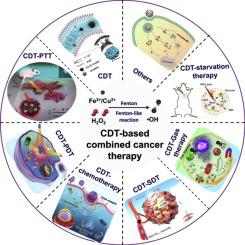当前位置:
X-MOL 学术
›
Nano Today
›
论文详情
Our official English website, www.x-mol.net, welcomes your
feedback! (Note: you will need to create a separate account there.)
Recent progress of chemodynamic therapy-induced combination cancer therapy
Nano Today ( IF 13.2 ) Pub Date : 2020-12-01 , DOI: 10.1016/j.nantod.2020.100946 Xianwen Wang , Xianyan Zhong , Zhuang Liu , Liang Cheng
Nano Today ( IF 13.2 ) Pub Date : 2020-12-01 , DOI: 10.1016/j.nantod.2020.100946 Xianwen Wang , Xianyan Zhong , Zhuang Liu , Liang Cheng

|
Abstract Chemodynamic therapy (CDT) is an emerging cancer treatment strategy that uses CDT agents to convert hydrogen peroxide (H2O2) into the hydroxyl radical ( OH), the most harmful reactive oxygen species (ROS) by the Fenton/Fenton-like reactions, thus inducing cell apoptosis and necrosis. This treatment method has been widely studied because of its minimal invasiveness and high tumor specificity, and has become a popular topic of research. Despite the great potential of CDT in tumor treatment, the clinical conversion of CDT is still facing challenges: 1) the relatively high pH of the tumor sites is not suitable for the occurrence of most Fenton/Fenton-like reactions; 2) the low concentration of endogenous H2O2 at the tumors is not enough to generate continuous ROS such as OH; and 3) the high expression of reducing substances (e.g., glutathione, GSH) in the tumor microenvironment (TME) weakens the therapeutic effect of CDT. These limitations make it difficult for CDT alone to completely eliminate malignant tumors. Therefore, CDT-based combined treatment strategies have been widely developed. CDT-based combined therapy refers to the combination of CDT and other cancer treatments (e.g., photo-induced therapy, chemotherapy, sonodynamic therapy, starvation therapy, and gas therapy), which can produce a synergistic anticancer effect. This combined therapy can reduce individual drug-related toxicity and significantly enhance therapeutic efficiency, which has recently seen rapid development. This review begins by defining CDT, then it identifies the problems faced in CDT and proposes various strategies to enhance CDT performance, primarily focusing on CDT-based combined cancer treatment. The problems, opportunities, and challenges of CDT-based combination cancer therapy are also summarized, thereby providing a reference for the future development of CDT-based combined therapy.
中文翻译:

化学动力学疗法诱导的联合癌症治疗的最新进展
摘要 化学动力学疗法 (CDT) 是一种新兴的癌症治疗策略,它使用 CDT 药物将过氧化氢 (H2O2) 通过芬顿/芬顿样反应转化为最有害的活性氧 (ROS) 羟基自由基 (OH),从而诱导细胞凋亡和坏死。这种治疗方法因其微创性和肿瘤特异性高而被广泛研究,成为热门的研究课题。尽管CDT在肿瘤治疗中潜力巨大,但CDT的临床转化仍面临挑战:1)肿瘤部位相对较高的pH值不适合大多数Fenton/Fenton样反应的发生;2)肿瘤内源性H2O2浓度低,不足以产生OH等连续的ROS;3) 还原性物质(如谷胱甘肽、肿瘤微环境 (TME) 中的 GSH) 削弱了 CDT 的治疗效果。这些限制使得单靠 CDT 难以完全消除恶性肿瘤。因此,基于 CDT 的联合治疗策略得到了广泛的发展。基于CDT的联合治疗是指CDT与其他癌症治疗(如光诱导疗法、化学疗法、声动力疗法、饥饿疗法和气体疗法)相结合,可产生协同抗癌作用。这种联合疗法可以降低个体药物相关的毒性并显着提高治疗效率,这在最近得到了快速发展。本综述首先定义 CDT,然后确定 CDT 面临的问题,并提出各种提高 CDT 性能的策略,主要侧重于基于 CDT 的联合癌症治疗。
更新日期:2020-12-01
中文翻译:

化学动力学疗法诱导的联合癌症治疗的最新进展
摘要 化学动力学疗法 (CDT) 是一种新兴的癌症治疗策略,它使用 CDT 药物将过氧化氢 (H2O2) 通过芬顿/芬顿样反应转化为最有害的活性氧 (ROS) 羟基自由基 (OH),从而诱导细胞凋亡和坏死。这种治疗方法因其微创性和肿瘤特异性高而被广泛研究,成为热门的研究课题。尽管CDT在肿瘤治疗中潜力巨大,但CDT的临床转化仍面临挑战:1)肿瘤部位相对较高的pH值不适合大多数Fenton/Fenton样反应的发生;2)肿瘤内源性H2O2浓度低,不足以产生OH等连续的ROS;3) 还原性物质(如谷胱甘肽、肿瘤微环境 (TME) 中的 GSH) 削弱了 CDT 的治疗效果。这些限制使得单靠 CDT 难以完全消除恶性肿瘤。因此,基于 CDT 的联合治疗策略得到了广泛的发展。基于CDT的联合治疗是指CDT与其他癌症治疗(如光诱导疗法、化学疗法、声动力疗法、饥饿疗法和气体疗法)相结合,可产生协同抗癌作用。这种联合疗法可以降低个体药物相关的毒性并显着提高治疗效率,这在最近得到了快速发展。本综述首先定义 CDT,然后确定 CDT 面临的问题,并提出各种提高 CDT 性能的策略,主要侧重于基于 CDT 的联合癌症治疗。









































 京公网安备 11010802027423号
京公网安备 11010802027423号